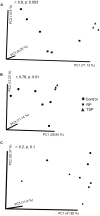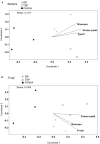Long-Term Rock Phosphate Fertilization Impacts the Microbial Communities of Maize Rhizosphere
- PMID: 28744264
- PMCID: PMC5504191
- DOI: 10.3389/fmicb.2017.01266
Long-Term Rock Phosphate Fertilization Impacts the Microbial Communities of Maize Rhizosphere
Abstract
Phosphate fertilization is a common practice in agriculture worldwide, and several commercial products are widely used. Triple superphosphate (TSP) is an excellent soluble phosphorus (P) source. However, its high cost of production makes the long-term use of crude rock phosphate (RP) a more attractive alternative in developing countries, albeit its influence on plant-associated microbiota remains unclear. Here, we compared long-term effects of TSP and RP fertilization on the structure of maize rhizosphere microbial community using next generation sequencing. Proteobacteria were dominant in all conditions, whereas Oxalobacteraceae (mainly Massilia and Herbaspirillum) was enriched in the RP-amended soil. Klebsiella was the second most abundant taxon in the RP-treated soil. Burkholderia sp. and Bacillus sp. were enriched in the RP-amended soil when compared to the TSP-treated soil. Regarding fungi, Glomeromycota showed highest abundance in RP-amended soils, and the main genera were Scutellospora and Racocetra. These taxa are already described as important for P solubilization/acquisition in RP-fertilized soil. Maize grown on TSP and RP-treated soil presented similar productivity, and a positive correlation was detected for P content and the microbial community of the soils. The results suggest changes of the microbial community composition associated to the type of phosphate fertilization. Whilst it is not possible to establish causality relations, our data highlights a few candidate taxa that could be involved in RP solubilization and plant growth promotion. Moreover, this can represent a shorter path for further studies aiming the isolation and validation of the taxa described here concerning P release on the soil plant system and their use as bioinoculants.
Keywords: maize rhizosphere; microbial community; rock phosphate.
Figures




References
-
- Aira M., Gomez-Brandon M., Lazcano C., Baath E., Dominguez J. (2010). Plant genotype strongly modifies the structure and growth of maize rhizosphere microbial communities. Soil Biol. Biochem. 42 2276–2281. 10.1016/j.soilbio.2010.08.029 - DOI
-
- Arruda L., Beneduzi A., Martins A., Lisboa B., Lopes C., Bertolo F., et al. (2013). Screening of rhizobacteria isolated from maize (Zea mays L) in Rio Grande do Sul State (south Brazil) and analysis of their potential to improve plant growth. Appl. Soil Ecol. 63 15–22. 10.1016/j.apsoil.2012.09.001 - DOI
-
- Baig K. S., Arshad M., Khalid A., Hussain S., Abbas M. N., Imran M. (2014). Improving growth and yield of maize through bioinoculants carrying auxin production and phosphate solubilizing activity. Soil Environ. 33 159–168.
LinkOut - more resources
Full Text Sources
Other Literature Sources
Miscellaneous

